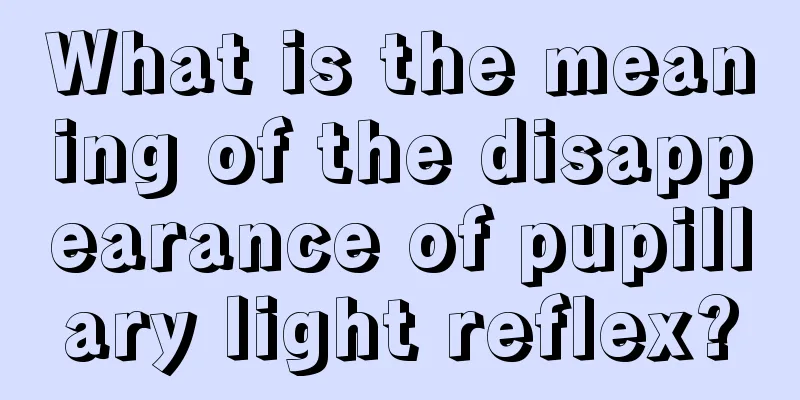What is the meaning of the disappearance of pupillary light reflex?

|
The eyes are very important to the body. If a person is seriously ill or has some kind of disease, it will easily show through the eyes. The pupil refers to an important part of the eye. Problems with the pupil will easily cause some eye diseases. The disappearance of the pupil's light reflex means that it disappears when the light shines on the pupil, which means that the patient is in a severe coma. What is the significance of the loss of pupillary light reflex? Light reflex is a test to examine pupillary function, which is divided into direct light reflex and indirect light reflex. The center of pupillary light reflex is in the anterior tectum of the midbrain, so it is often used clinically as an important indicator to determine the location of central nervous system lesions, the depth of anesthesia and the severity of the disease. Light reflex can be divided into direct light reflex and indirect light reflex. Direct light reflex, usually by shining a flashlight directly into the pupil and observing its dynamic reaction. In a normal person, the pupil shrinks immediately when the eye is stimulated by light, and recovers quickly when the light source is removed. Indirect light reflex means that when light shines on one eye, the pupil of the other eye shrinks immediately, and when the light is removed, the pupil dilates. When checking the indirect light reflex, you should block the light with one hand to prevent the examined eye from being exposed to the light and causing a direct light reflex. The pupil's light reflex is slow or absent, which is seen in comatose patients. The efferent nerves are the parasympathetic fibers of the oculomotor nerve Overview The axons of the accessory nucleus of the oculomotor nerve (parasympathetic preganglionic fibers) travel through the oculomotor nerve to the ciliary ganglion to replace neurons, and the postganglionic fibers innervate the pupillary sphincter, causing bilateral pupil constriction. Damage at any point in the light reflection pathway can cause the light reflection to weaken or disappear. The pupillary light reflex is the constriction of the pupil caused by light stimulation. Damage to any part of the light reflex conduction pathway can cause the light reflex to weaken or disappear. Pupillary light reflex adjustment Normal pupil The normal pupil size is related to factors such as age, physiological state, refraction, and external environment. The pupils of infants under one year old are the largest, followed by those of children and adolescents. As they grow and develop, their pupils will gradually become smaller. The pupil of a myopic eye is larger than that of a hyperopic eye; when the sympathetic nerves are excited, such as when experiencing fear, anxiety, or pain, the pupil will dilate; when the parasympathetic nerves are excited, such as when experiencing deep breathing, mental work, or sleep, the pupil will become smaller. The average diameter of a normal pupil under natural light is 2.5 to 4 mm. Both sides are equal in size and round, with neat edges. They may shrink under bright light and slightly enlarge under dim light. If you shine a flashlight on your pupil when your eyes are looking straight ahead, it will immediately shrink. Move away the light source or close your eyes and the pupil will recover. examine For a normal person, when a flashlight is shone directly on one pupil, it can be observed that the pupil on that side shrinks immediately when stimulated by the light. If the light source is removed at this time, the pupil can be observed to recover immediately. Use the same method to observe the pupil on the other side. This is a direct reflection of light. Place one hand vertically between your eyes to block the flashlight from shining on the opposite side. At this time, if you shine a flashlight on one pupil, you can observe that the other pupil shrinks immediately, and the pupil recovers immediately when the light is removed. Check the contralateral pupil in the same way, and if it shows the same result, it is normal. This is an indirect light reflection. Both direct light reflex and indirect light reflex are functional activities for detecting the pupil. If a flashlight is shone on the pupil, there is little change, and the pupil does not enlarge significantly after the light source is removed. This condition is called unresponsive pupil to light. When the pupil does not react to light at all, it is called anophelotic. Both conditions are common in comatose patients. |
<<: What are pupil changes in acute glaucoma?
>>: What should I do if my pupils turn white?
Recommend
What are the symptoms of laryngeal hypertrophy?
Some babies will develop symptoms of laryngeal st...
How long can you live after laryngeal cancer surgery
How long you can live with cancer depends on many...
How to wash off gel pen ink
I believe that everyone must have used a gel pen ...
Will I get fat if I don't eat in the morning?
Breakfast can be said to be the most important me...
Will getting angry cause blurry eyes?
The hot weather in summer can easily lead to the ...
My waist hurts when I squat or bend over
Some people may find themselves with this problem...
Papular dermatitis
This situation often happens in our daily life. S...
How to cut fried ham sausage into pieces
Ham sausage is a popular meat-like food, which is...
What kind of disease is endometrial cancer
What kind of disease is endometrial cancer? The o...
What is the difference between Qiyi fruit and kiwi fruit
Many people cannot tell the difference between ki...
Is running aerobic or anaerobic
For women, if they want to lose weight, they are ...
What is the relationship between emotions and diseases
As we age, many parts of the human body will age,...
How long should it take before eating crabs and persimmons?
Although "eat" is a simple word, it mea...
What are the nursing measures for high body temperature?
High body temperature is a common condition in da...
What are the methods for diagnosing lung cancer? Hospitals often use 4 methods to diagnose lung cancer
Lung cancer is a disease that is not unfamiliar t...









